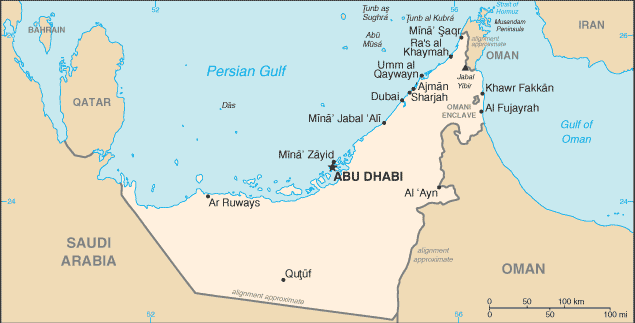Map:

Overview:
The Trucial States of the Persian Gulf coast granted the UK control of their defense and foreign affairs in 19th century treaties. In 1971, six of these states - Abu Zaby, 'Ajman, Al Fujayrah, Ash Shariqah, Dubayy, and Umm al Qaywayn - merged to form the United Arab Emirates (UAE). They were joined in 1972 by Ra's al Khaymah. The UAE's per capita GDP is on par with those of leading West European nations. Its generosity with oil revenues and its moderate foreign policy stance have allowed the UAE to play a vital role in the affairs of the region.
The People:
Population: 2,563,212
note: includes an estimated 1,606,079 non-nationals; the 17 December 1995 census presents a total population figure of 2,377,453, and there are estimates of 3.44 million for 2002 (July 2005 est.)
Age structure:
0-14 years: 25.3% (male 331,269; female 317,977)
15-64 years: 71.1% (male 1,115,826; female 707,058)
65 years and over: 3.6% (male 66,404; female 24,678) (2005 est.)
Religions:
Muslim 96% (Shi'a 16%), Christian, Hindu, and other 4%
Government Type:
federation with specified powers delegated to the UAE federal government and other powers reserved to member emirates
Leader(s) to pray for:
chief of state: President Sheikh KHALIFA bin Zayid Al Nuhayyan (since 3 November 2004), ruler of Abu Zaby (Abu Dhabi) (since 4 November 2004) and Vice President MAKTUM bin Rashid al-Maktum (since 8 October 1990), ruler of Dubayy (Dubai)
head of government: Prime Minister MAKTUM bin Rashid al-Maktum (since 8 October 1990), ruler of Dubayy (Dubai); Deputy Prime Minister SULTAN bin Zayid Al Nuhayyan (since 20 November 1990); Deputy Prime Minister HAMDAN bin Zayid Al Nuhayyan (since 20 October 2003)
Source: The World Factbook
View All Countries